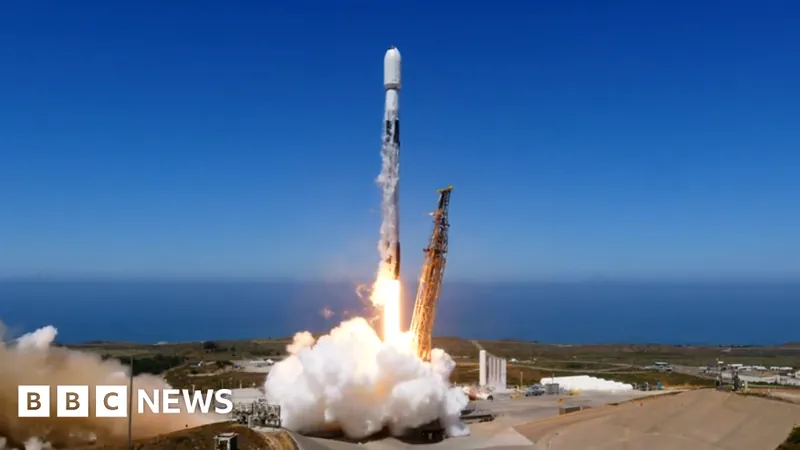
Rays Left in Limbo: Where Will They Play in 2025 After Hurricane Milton's Devastation?
2024-10-16
Author: Ying
ST. PETERSBURG — The aftermath of Hurricane Milton has left Tropicana Field reeling, its roof shredded and structural integrity in question.
With the MLB season opener rapidly approaching on March 27, 2025, uncertainty abounds regarding the future home of the Tampa Bay Rays.
The destruction of the stadium, a critical hub for the Rays, has posed numerous questions about their short- and long-term plans. Initial assessments suggest they won’t be returning home as planned, pushing the organization to contemplate temporary alternatives. As Rays officials sift through the chaos, the hope is to establish a strategy to address repairs and secure a plan for the upcoming seasons.
Access to Tropicana Field has been severely restricted due to safety hazards, particularly regarding the integrity of the roof's supports. Early indications reveal extensive damage that extends beyond the roof, with team offices exposed to the elements on the fourth floor, highlighting the vulnerability of the venue.
Speaking to staff last week, team leadership admitted, “There are more questions than answers,” perpetuating the uncertainty about their immediate future. The most pressing question on everyone's mind remains: Where will the Rays play in 2025?
Options are both numerous and complicated. There is a possibility of a temporary relocation ranging from a few months to a full season, or even three years. Major League Baseball and the Players Association will also have a significant role in determining the pathways forward.
Nearby minor-league venues, like St. Petersburg’s Al Lang Stadium and Clearwater’s BayCare Ballpark, could potentially host the Rays, albeit with the requirement for upgrades. However, none of these options feature roofs, making weather delays a likely issue. The complications extend to operational logistics, such as accommodating existing minor-league schedules and securing the availability of game-day staff.
Although familiar with Port Charlotte and the Disney complex, the Rays may encounter additional complications regarding logistics, weather, and facilities. They may also consider options as far afield as Charlotte, North Carolina, or even San Juan, Puerto Rico, which once hosted MLB games, as they aim to remain within the Eastern Time Zone for broadcasting—an essential factor for fan engagement and revenue.
Beyond the immediate concern of where they will play, the extent of the damages at Tropicana Field will take precedence. Engineering experts are poised to assess the structural integrity of the entire facility, including the large video board and areas exposed to the storm. Not only does the roof need replacement, but structural evaluation will dictate the financial and temporal commitments necessary to restore the stadium.
The city of St. Petersburg bears responsibility for the repairs, with insurance claims already under consideration. However, navigating the complexities of such processes can be cumbersome, and Daytona’s recent hurricane recovery efforts foreshadow potential challenges in getting repairs underway.
Playing without a roof seems unfeasible as the stadium, designed as a multi-purpose enclosed venue, lacks a drainage system. Persistent rain would jeopardize gameplay and safety, underscoring the urgency for repairs if they wish to resume operations.
Financial sustainability is also a concern. Relocation could lead to reduced revenue from ticket sales and sponsorships, potentially resulting in staff reductions or furloughs. The situation is unprecedented, prompting speculation about whether MLB might provide financial assistance to the Rays during this critical juncture.
As discussions about the new stadium slated for 2028 progress, the extent of the current damages will influence future decisions. With ongoing assessments, the city will have to weigh the cost of immediate repairs against a fundamental understanding that Tropicana Field will ultimately be replaced.
Historically, similar incidents involving stadium damage have led to significant disruptions in operations. Comparisons to the collapse of the Metrodome roof in 2010 or the Superdome’s recovery post-Katrina serve as reminders of the delicate balance that major sports teams must maintain amidst natural calamities.
As the clock ticks down to the 2025 season opener, the Tampa Bay Rays face a multitude of obstacles that will test their resilience and adaptability. As every frustrating day passes without clarity, one thing remains certain: the path forward will require ingenuity and teamwork, both on and off the field. Hang tight, Rays fans—the coming weeks are bound to bring critical updates that could reshape the landscape of Major League Baseball for years to come!



 Brasil (PT)
Brasil (PT)
 Canada (EN)
Canada (EN)
 Chile (ES)
Chile (ES)
 España (ES)
España (ES)
 France (FR)
France (FR)
 Hong Kong (EN)
Hong Kong (EN)
 Italia (IT)
Italia (IT)
 日本 (JA)
日本 (JA)
 Magyarország (HU)
Magyarország (HU)
 Norge (NO)
Norge (NO)
 Polska (PL)
Polska (PL)
 Schweiz (DE)
Schweiz (DE)
 Singapore (EN)
Singapore (EN)
 Sverige (SV)
Sverige (SV)
 Suomi (FI)
Suomi (FI)
 Türkiye (TR)
Türkiye (TR)